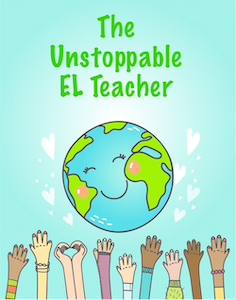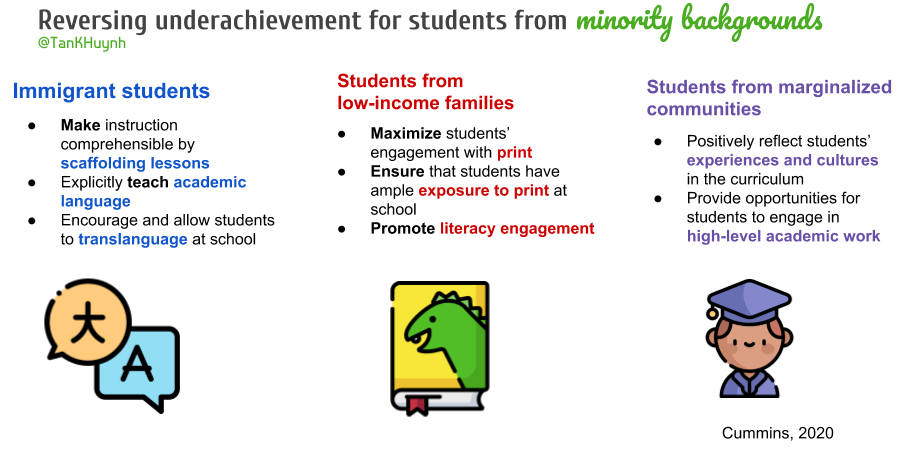A Champion of Home Language and Culture
A MiddleWeb Blog

I want to summarize some of the big ideas Jim shared during my recent podcast interview with him. In an hour-long chat, he takes us on a trip along his career timeline, tracing the evolution of his work over the past five decades of championing home languages and culture.
Cummins is Professor Emeritus at the Ontario Institute for Studies in Education (University of Toronto) where he worked on language and literacy development of English learners.

Advocate for Bilingualism
In the 1960s there were general misunderstandings around bilingualism. Many people thought learning and possessing two languages simultaneously would confuse children and prevent them from learning another language. This misguided belief was called first language interference. This assumption caused some teachers to punish students when they used their home languages at school.
However, research found that the opposite was true (Peel & Lambert, 1962). Cummins suggested that bilingualism was not the cause of underachievement. In fact, when both languages developed, there were cognitive, linguistic, and academic benefits (Cummins & Gulustan, 1974).
We want students to be biliterate because developing literacy in one language develops awareness of how another language works.
The Threshold Hypothesis
For the positive benefits of bilingualism to take root, though, a child must have a certain level of literacy proficiency in the languages they are learning (Cummins, 1976). Since many students from minority-language backgrounds were not receiving scaffolded instruction while learning under English-only policies, they did not develop high levels of literacy in any language.
Sadly, this side effect caused some people to think that students from minority language backgrounds were intellectually inferior.
The Linguistic Interdependence Hypothesis
When students from minority-language backgrounds were educated bilingually and when they had opportunities to develop literacy in both languages, they had far superior academic results compared to students who were submerged in a monolingual program (Cummins, 1979). Their common underlying proficiency helped them transfer their skills across languages. In other words, students can transfer knowledge (e.g., concept, content knowledge, curriculum content) learned in one language to another.
Therefore, minoritized students in bilingual programs did not lose out on English development because they could transfer what they had learned in a home language into English. For example, a student who learned about ecosystems in Spanish was developing both their Spanish skills and their content knowledge about ecosystems. They then naturally transferred both skills to a science class taught in English.
Factors of Underachievement
Lower power and status in broader society directly lead to underachievement for students from minority backgrounds (Cummins 1989). Some teachers may have lower expectations for students from a lower-status background. They may think that language learners will not do well so they provide less on-grade level work or lower the academic rigor.
For language learners to be successful in schools, we have to do more than just scaffold instruction, reinforce students’ awareness of academic language, and acknowledge and support their home language development.
We also need to create instructional contexts where students’ identities are affirmed and they develop the sense that they are capable of strong academic achievement. Cummins suggests that teachers have to challenge the corrosive power struggles that are operating in the broader society. We can do this by implementing instructional strategies that reflect students’ background experiences and cultures in a positive light.
Low Academic Achievement
If we want to correct broader educational policies to enable all students to succeed academically, then we have to ask, “Who are the students that tend to underachieve?”
In this interview, Cummins suggests that three groups tend to underachieve in most societies. This trio excludes dually-identified language learners as he believes they have individual issues that impact their achievement. The three groups include:
- Students from immigrant backgrounds
- Students from low-income families
- Students from communities that have been marginalized (Organisation for Economic Co-operation and Development, 2010)
Though these categories of students are conceptually different, they overlap in many contexts.
Reversing Underachievement
There are different evidence-based strategies to support students in each of these categories (Cummins, 2014).
►Students from immigrant backgrounds
Teachers can scaffold instruction to make content comprehensible, reinforce awareness of how academic language works (i.e., explicitly teach academic language), and encourage students to mobilize resources from their multilingual repertoire through translanguaging.
►Students from low-income families
Teachers can address the underachievement that is directly connected to the poverty levels and educational experiences of parents by maximizing students’ engagement with print. This can be done by ensuring that students have ample exposure to print in the school environment such as providing ample time for independent reading. Additionally, educators can focus on literacy engagement as a prime way to develop literacy skills.
►Students from communities that have been marginalized
For students who come from communities that have been targeted by racism, we have to affirm students’ identity. This support means having students engage with high-level academic work where they can see their intelligence reflected, their languages as a valuable asset, and their multilingualism as something positive.
A Dispeller of Myths
I owe so much to Jim Cummin’s four-plus decades of work – from advocating for home languages, developing the concept of social and academic language, and now negotiating identities between teachers and language learners.
When we step back, it seems that his work has helped us dispel the myths around home language use, highlight the benefits of multilingualism, and provide actionable strategies we can implement to empower students from minority backgrounds.




































